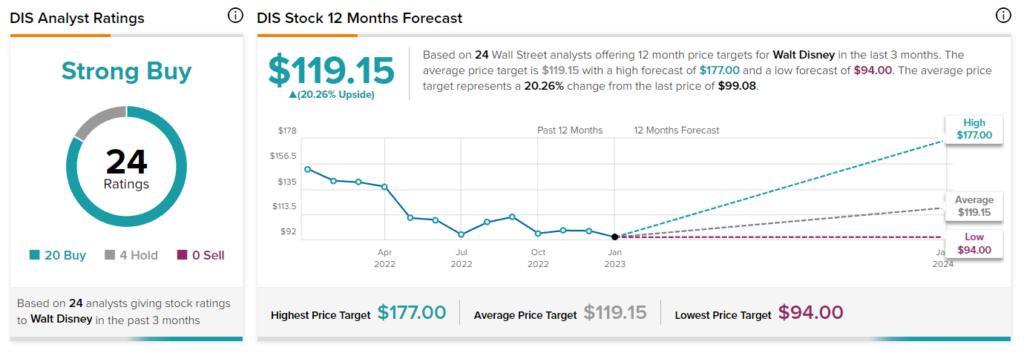The Walt Disney Company (NYSE:DIS) stock is down about 25% over the past year, which raises the question of whether the media giant represents a good buying opportunity. The question becomes even more compelling considering that Disney stock is currently trading at the same levels it was trading at in 2015 – and that was way before the company launched its Disney + service, which is now one of its biggest growth divers.

In my view, Disney certainly represents a more attractive investment opportunity following its extended decline, especially considering that its Fiscal 2022 results saw significant year-over-year improvements.
That said, I am worried about the company’s direct-to-consumer (DTC) segment, which may fail to grow in a saturated market, as well as the stock’s relatively elevated valuation multiple based on current earnings projections.
A Solid Fiscal 2022, but Disney Has More to Prove
Disney ended its Fiscal 2022 with a relatively solid performance, especially in some of its segments, like Linear Networks and Parks. That said, the company also has a lot more to prove moving forward, primarily when it comes to improving the profitability of its DTC services.
It’s important to remember that while Disney is currently in a transition phase, with investors speculating on the performance of its growing businesses, including Disney+, the majority of the company’s revenues and profits are still being generated by its legacy businesses. Let’s take a look at its segments.
Linear Networks Segment Remains a Cash Cow
For instance, Linear Networks, which generated revenues from fees the company charges to affiliates who air and advertise on its channels, comprised 33% of Disney’s total revenues for the year. While the segment did see a boost a few years back due to Disney’s acquisition of 20th Century Fox, the long-term trend here is dominated by customers cutting the cord as they turn toward streaming. Nevertheless, the Linear Networks division remains a cash cow for Disney, as it generated an operating profit of $8.5 billion during the year, implying an operating margin of 30% on revenues of $28.3 billion.
Parks, Experiences, and Products Saw an Explosive Recovery
Further, I am pleased with Disney’s performance in its Parks, Experiences, and Products division, whose revenues are primarily generated from the sale of tickets to Disney’s theme parks and resorts, as well as the money visitors spend on food, beverages, and merchandise there.
The segment, in fact, saw an explosive recovery from the previous year’s results, which had been greatly impacted by the COVID-19 pandemic. In fact, its revenues came in at $28.7 billion, up 73% year-over-year. Besides record revenues, the segment also achieved record operating income, which amounted to $7.9 billion, a massive improvement from Fiscal 2021’s operating income of just $471 million.
Direct-To-Consumer Segment Leaves Me Skeptical
Nevertheless, when it comes to Disney’s DTC segment, which records revenues received from the company’s streaming platforms, including Disney+, Hulu, ESPN+, and Star+, I am quite skeptical.
On the positive side, the company has done a fantastic job in terms of growing its subscriber base on Disney+. Nobody can argue against that, especially given that Disney was late to the party with launching its own SVOD service.
In particular, the company ended the year with 164.2 million Disney+ subscribers, representing year-over-year growth of 39%. For context, the company had just 26.5 million subscribers at the beginning of 2020, which illustrates just how incredible its growth trajectory has been over the past three years.
That said, whether Disney will be able to turn this segment profitable remains ambiguous. The DTC segment recorded operating losses of $4 billion during Fiscal 2022, with losses significantly widening from the previous year’s operating loss of $1.7 billion.
Growing profitability in the segment is a double-edged sword for Disney because that would require increasing the cost of Disney+ to expand its average revenue per user (ARPU). That would slow down the growth of the platform massively, though, as the space is already highly crowded.
My concerns were amplified further following Netflix’s (NASDAQ:NFLX) Q4 results coming in quite soft. Being a bellwether in the industry, Netflix’s results can provide great insight in terms of where the overall trend in the SVOD space is headed. Thus, seeing NFLX’s revenue growth decelerating to 2% for the quarter (or 10% in constant currency) and the company achieving a measly 4% growth in average paid memberships, it only makes sense to worry about Disney+ growth and the platform’s profitability prospects.
If Disney+ can’t scale as rapidly as before, since streaming platforms have already begun to lose steam amid growing competition, it’s hard to tell how and when Disney’s DTC segment will start contributing to the bottom line.
Is DIS Stock a Buy, According to Analysts?
Turning to Wall Street, Disney has a Strong Buy consensus based on 20 Buys and four Holds assigned in the past three months. At $119.15, the average Disney stock price forecast suggests 20.26% upside potential.

The Takeaway
Clearly, Wall Street analysts have grown increasingly bullish on Disney stock following its extended decline. I can’t say this point of view is unjustified, as Disney’s legacy segments remain highly profitable while the number of subscribers in the Disney+ streaming service continues to grow rather aggressively.
That said, for me, Disney has much more to prove before I am to turn bullish on the stock. Its DTC segment is struggling to record profits during a time in which the space is becoming increasingly congested, and that’s a tough situation.
The company must solidify its position in the space with profitable DTC results to convince me the segment won’t be a long-term loser in the face of developing competition. Besides, at a forward P/E ratio of 23.7x compared to the sector median forward P/E ratio of 16.9x, investors have little to no margin of safety if Disney fails to grow its earnings relatively rapidly in the coming years, which is another notable risk to keep in mind.
Join our Webinar to learn how TipRanks promotes Wall Street transparency









